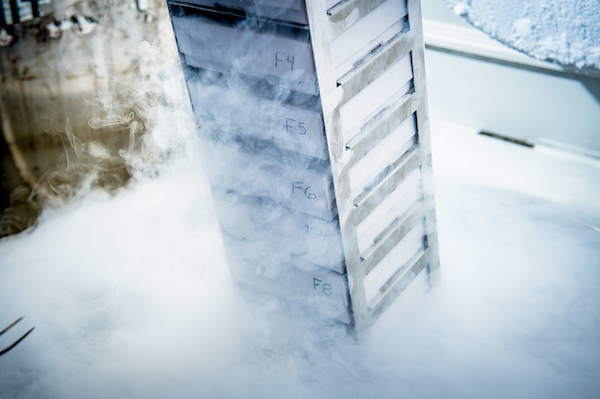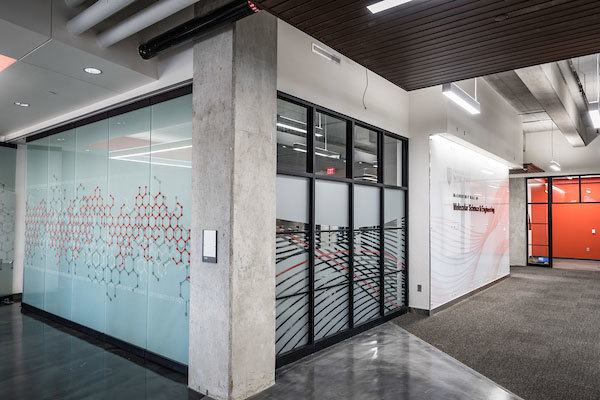
Notre Dame researcher uses tumor cells to evaluate the effectiveness of current medications
 Amanda Hummon, Huisking Foundation, Inc. Associate Professor of Chemistry and Biochemistry
Amanda Hummon, Huisking Foundation, Inc. Associate Professor of Chemistry and Biochemistry
In recent years researchers have begun to understand that the development of colon cancer, which is the second most common cancer in the United States, can impact the genome and cause protein changes within cancer cells. This knowledge has brought new medications and targeted therapies to the marketplace and now a Notre Dame researcher is evaluating the effectiveness of these treatments.
From her laboratory within Notre Dame’s newly opened McCourtney Hall, a 220,000 square foot building dedicated to research in the molecular sciences and engineering, Amanda Hummon, Huisking Foundation, Inc. Associate Professor of Chemistry and Biochemistry and affiliate of the Harper Cancer Research Institute (HCRI) and Advanced Diagnostics and Therapeutics initiative, is conducting fundamental research on the differences between cancer on the right versus the left side of the colon to evaluate cancer medications.
To do so, Hummon’s lab grows three-dimensional cancer cell structures from colon cancer cell lines. Once a cell line has been grown into a tumor model, the lab can test a medication and see how well it moves through the model by using mass spectrometry. The mass spectrometry data allows Hummon to map the pathways of the different medications and look at how far the medicine penetrates into the tumor model.
 Frozen tissue in the Hummon lab
Frozen tissue in the Hummon lab
Hummon’s findings have shown that most medications do not penetrate the entire tumor. Instead, the medication is mostly killing the outer cancer cells. For slower growing tumors, this can be especially dangerous. She explained, “In every situation, you want to kill the entire tumor. However, a slow growing tumor is more likely to recruit a blood vessel, keeping both the outer and inner tumor cells alive. So far, the medications we have evaluated are treating the cells on the outside of the tumor, meaning there are cells within the tumor structure left untouched.”
Hummon’s colon cancer tumor models are also being used in collaboration with Bradley D. Smith, Emil T. Hofman Professor of Chemistry and Biochemistry, director of the Notre Dame Integrated Imaging Facility, and member of HCRI. In an effort to create more effective treatment options, the Smith lab, which has also recently relocated to McCourtney Hall, has designed probes to detect tumors or, more specifically, the dead cells typically found in the middle of a fast-growing tumor. These probes are designed to bind to the dead or dying tumor cells. Then the researchers can evaluate the penetration of the probes by again using mass spectrometry.
“This is an ongoing project that fit well with the work my lab was already doing,” said Hummon. “All of our research is dedicated to learning as much as possible about improving current treatment options for cancer patients and our collaboration can only improve the potential to accomplish that.”
 Interior of McCourtney Hall
Interior of McCourtney Hall
As residents of the newly opened McCourtney Hall, Hummon and Smith are a part of a cross-disciplinary effort to tackle three key programmatic areas within the building: analytical sciences and engineering, chemical and biomolecular engineering, and drug discovery. From brain injuries to clean water, cancer treatment to sustainable energy and climate change, researchers within McCourtney Hall are working to discover new technologies in the face of the world’s grand challenges and to advance Notre Dame’s mission to be a powerful means for doing good in the world.
If you would like to learn more about Amanda Hummon’s novel work with three-dimensional tumor models, click here.
Contact:
Brandi Klingerman / Research Communications Specialist
Notre Dame Research / University of Notre Dame
bklinger@nd.edu / 574.631.8183
research.nd.edu / @UNDResearch
About Notre Dame Research:
The University of Notre Dame is a private research and teaching university inspired by its Catholic mission. Located in South Bend, Indiana, its researchers are advancing human understanding through research, scholarship, education, and creative endeavor in order to be a repository for knowledge and a powerful means for doing good in the world. For more information, please see research.nd.edu or @UNDResearch.